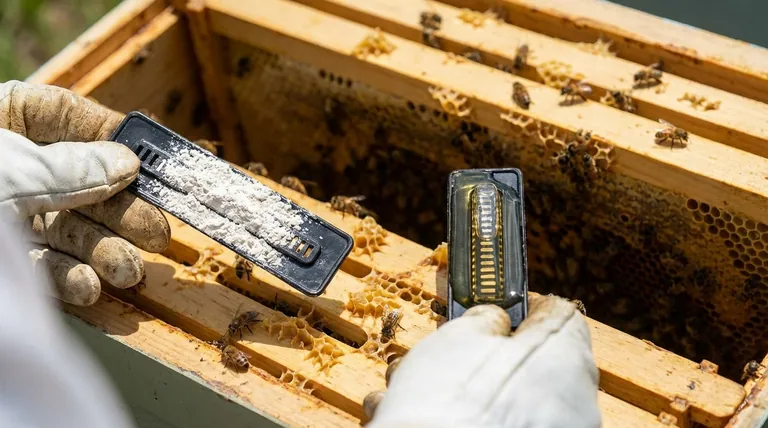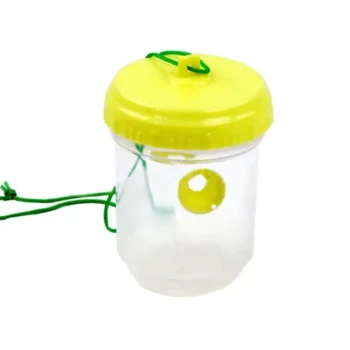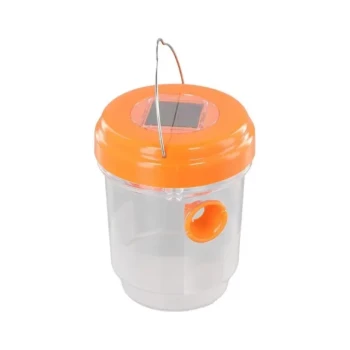The single most important precaution when using diatomaceous earth (DE) in Beetle Blasters is to prevent it from spilling or becoming airborne where it can contact your honey bees. Although intended for Small Hive Beetles, DE is an indiscriminate mechanical insecticide. It will harm any insect with an exoskeleton, including the bees you are trying to protect.
While diatomaceous earth can be used to control hive beetles, its non-selective nature presents a significant risk to bee health. The core challenge is not just using it, but containing it perfectly to avoid collateral damage to your colony.

How Diatomaceous Earth Works
A Mechanical Abrasive, Not a Poison
Diatomaceous earth is not a chemical poison. It is the fossilized remains of microscopic aquatic organisms called diatoms, which are milled into a fine, silica-rich powder.
Under a microscope, these particles have sharp, abrasive edges.
The Action Against Insects
When an insect like a Small Hive Beetle comes into contact with DE, the sharp particles scrape away the waxy outer layer of its exoskeleton.
This waxy coating is critical for retaining moisture. Once compromised, the insect rapidly loses water, dehydrates, and dies. As the references note, this is not an instantaneous process; it shortens the insect's lifespan.
Why It Is Indiscriminate
This mechanical action is effective on any insect with a similar exoskeleton. A honey bee's body and delicate wing membranes are just as vulnerable to the abrasive qualities of DE as a beetle's shell. It cannot distinguish between a pest and a beneficial insect.
The High Risk to Your Honey Bee Colony
The Danger of Spills and Dust
The primary risk comes from accidental contamination. If DE is spilled on top bars, honeycomb, or the hive's bottom board, bees will inevitably walk through it.
Any airborne dust created while filling the traps can settle throughout the hive or be inhaled by bees, causing respiratory damage.
Direct Harm to Bees
A bee that makes contact with DE will suffer the same fate as a beetle. Its exoskeleton will be abraded, leading to dehydration and a shortened life. This undermines the overall health and population of the colony.
Vulnerability of Brood
Nurse bees tending to larvae can inadvertently track the powder into brood cells, potentially harming the developing bees.
Understanding the Trade-offs and Alternatives
The Superiority of Oil
For use in Beetle Blaster-style traps, mineral oil or vegetable oil is a far safer and equally effective alternative.
Beetles seeking a dark place to hide will crawl into the trap and drown in the oil. This method is self-contained and poses almost no risk to the bee population, as bees are not attracted to the oil.
The Question of Efficacy
Oil provides a more certain outcome by physically trapping and drowning the beetles. DE relies on contact and a slower process of dehydration, and its effectiveness is compromised if it becomes wet.
Traps Are Only One Part of the Solution
Remember that traps are tools for monitoring and reducing beetle numbers, not for eliminating them entirely. The best defense against Small Hive Beetles is maintaining a strong, healthy, and populous bee colony that can police its own hive.
Making the Right Choice for Your Hive
Ultimately, your strategy should prioritize the health and safety of your colony. Before using any agent inside the hive, carefully weigh its benefits against the potential risks.
- If your primary focus is maximum bee safety: Avoid diatomaceous earth inside the hive entirely. Use mineral oil or vegetable oil in your traps, as it is a highly effective and bee-safe alternative.
- If you are absolutely committed to using diatomaceous earth: Fill the traps far away from the hive to prevent any airborne dust from entering. Handle the filled traps with extreme care to ensure zero spillage during placement and removal.
- If your goal is long-term beetle management: Concentrate your efforts on proper hive management to ensure a strong, populous colony that can effectively defend itself.
Choosing the safest possible tool is a cornerstone of responsible and successful beekeeping.
Summary Table:
| Key Precaution | Why It's Important | Safer Alternative |
|---|---|---|
| Prevent Spills & Airborne Dust | DE is an indiscriminate insecticide that harms bees on contact | Use mineral or vegetable oil in traps instead |
| Fill Traps Away from Hive | Reduces risk of bees inhaling or contacting the powder | Oil traps are self-contained and bee-safe |
| Prioritize Strong Colony Health | Healthy bees can better defend against beetles naturally | Focus on hive management over chemical controls |
Protect Your Investment with the Right Equipment
As a commercial beekeeper or distributor, your colony's health is your livelihood. While proper pest management is crucial, using the wrong tools can devastate your operation.
HONESTBEE supplies commercial apiaries and beekeeping equipment distributors with wholesale-focused solutions that support sustainable, effective hive management. From durable equipment to proven pest control tools, we help you maintain strong, productive colonies.
Let's discuss how our beekeeping supplies can strengthen your operation — contact our wholesale team today for customized solutions and pricing.
Visual Guide

Related Products
- Plastic Beetle Blaster Trap Beekeeping Tools and Supplies
- Reusable Aluminium Beetle Trap for Small Hive Beetles Silver Bullet
- Reusable Clear Small Hive Beetle Traps for Beehives Beetle Trapping Tools
- Black Plastic Beetle Barn Hive Beetle Trap for Beehives
- Removable Washable Hive Beetle Trap Attractants for Small Hive Beetles
People Also Ask
- How do beetle traps like Beetle Blasters support bee colonies? Protect Your Hives from Destructive Pests
- What are the steps for installing hive beetle traps? A Guide to Effective Beetle Control
- What is the primary function of Beetle Blasters? Control Small Hive Beetles Effectively
- What should be avoided when installing Beetle Blasters in a hive? Avoid These 3 Costly Placement Mistakes
- What is the purpose of the small hive beetle tray? A Non-Chemical Pest Control Solution



















